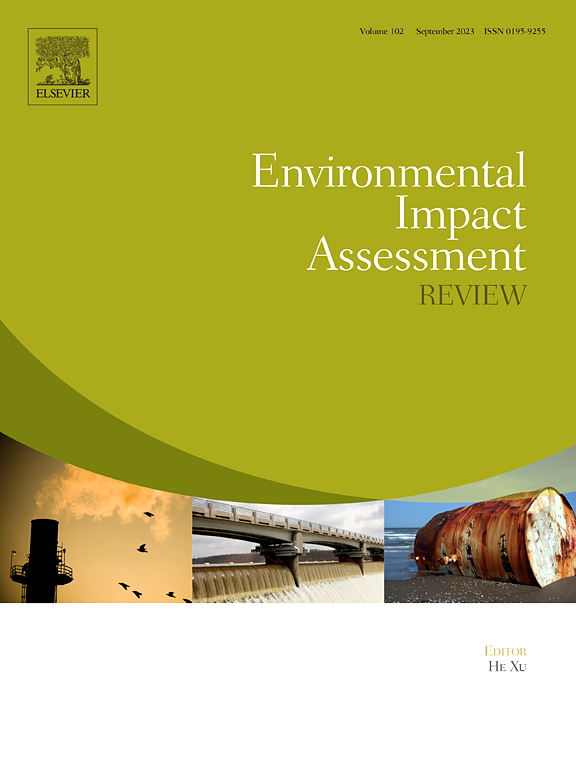Intensified coupling of regional water and energy efficiencies by wastewater treatment-coal power infrastructure symbiosis
IF 11.2
1区 社会学
Q1 ENVIRONMENTAL STUDIES
引用次数: 0
Abstract
Inadequate coupling between interdependent and interacting water and energy systems impairs both resource efficiency and attainment of sustainable development goals. Wastewater treatment-coal power infrastructure symbiosis has proved to offer potentials for water and energy savings, and greenhouse gases (GHG) mitigations, which is crucial for integrated water-energy co-management. However, how such infrastructure symbiosis facilitates to enhance regional water and energy efficiencies and thus consolidate water-energy synergy remains unclear. Based on an integrated water-energy network, the total factor water and energy efficiencies and their historical trajectories during 2006–2023 in 30 Chinese provincial regions are examined employing super-efficient Slack-Based Measure (SBM) model, with the coupling of efficiencies evaluated. The water-energy-environmental-efficiencies co-benefits of the infrastructure symbiosis and efficiencies coupling enhancement are explored through comparing a baseline scenario and a new symbiosis scenario (incorporating enhanced coal-sludge co-combustion and water reuse). Results show a progressive improvement in regional water and energy efficiencies, with their annual average coupling degree escalating from 0.19 to 0.35, although significant regional imbalance persists. In conjunction with a reduction of 5.80 million tons of coal, 1.39 billion m3 of freshwater use, and 16.77 million tons of CO2-equivalent, the infrastructure symbiosis can facilitate a maximum enhancement in energy efficiency as 0.30, and in water efficiency as 0.01 across regions. Outstanding enhancements in the coupling are observed in Beijing (+0.006), Shanghai (+0.002), and Zhejiang (+0.0004). This study clarifies the spatiotemporal variations in the coupling between water and energy systems as represented by the efficiencies, and provides critical evidence for designing differentiated water-energy co-management policies based on the infrastructure symbiosis.

污水处理-煤电基础设施共生强化区域水能源效率耦合
相互依赖和相互作用的水和能源系统之间耦合不充分会损害资源效率和实现可持续发展目标。废水处理-煤电基础设施共生已被证明具有节约用水和能源以及减少温室气体(GHG)的潜力,这对综合水能协同管理至关重要。然而,这种基础设施共生如何促进提高区域水和能源效率,从而巩固水-能源协同作用仍不清楚。基于综合水能网络,采用超高效的基于Slack-Based测度(SBM)模型,研究了2006-2023年中国30个省区的全要素水能源效率及其历史轨迹,并对效率耦合进行了评价。通过比较基线情景和新的共生情景(包括加强煤污泥共燃烧和水回用),探讨了基础设施共生和效率耦合增强的水-能源-环境效率协同效益。结果表明:区域水和能源效率逐步提高,年平均耦合度从0.19上升到0.35,但区域不平衡仍然存在;在减少580万吨煤炭、13.9亿立方米淡水和1677万吨二氧化碳当量的同时,基础设施共生可以促进各地区能源效率的最大提高0.30,水效率的最大提高0.01。北京(+0.006)、上海(+0.002)和浙江(+0.0004)的耦合显著增强。本研究阐明了以效率为代表的水能耦合的时空变化特征,为设计基于基础设施共生的差别化水能协同管理政策提供了重要依据。
本文章由计算机程序翻译,如有差异,请以英文原文为准。
求助全文
约1分钟内获得全文
求助全文
来源期刊

Environmental Impact Assessment Review
ENVIRONMENTAL STUDIES-
CiteScore
12.60
自引率
10.10%
发文量
200
审稿时长
33 days
期刊介绍:
Environmental Impact Assessment Review is an interdisciplinary journal that serves a global audience of practitioners, policymakers, and academics involved in assessing the environmental impact of policies, projects, processes, and products. The journal focuses on innovative theory and practice in environmental impact assessment (EIA). Papers are expected to present innovative ideas, be topical, and coherent. The journal emphasizes concepts, methods, techniques, approaches, and systems related to EIA theory and practice.
 求助内容:
求助内容: 应助结果提醒方式:
应助结果提醒方式:


